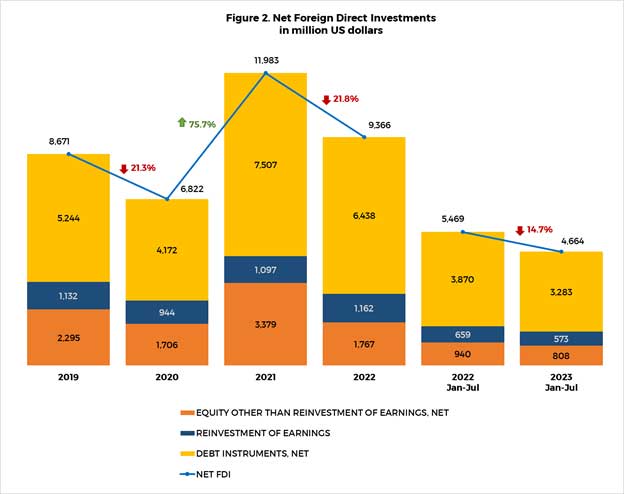Foreign direct investment (FDI) net inflows amounted to US$753 million in July 2023, higher by 35.7 percent than the US$555 million recorded net inflows in the same month last year (Figure 1).1, 2
The growth in FDI was mainly on account of the 108.4 percent increase in nonresidents’ net investments in debt instruments (to US$575 million from US$276 million), which more than offset the decrease in nonresidents’ net investments in equity capital (other than reinvestment of earnings) by 52.6 percent (to US$65 million from US$137 million) and their reinvestment of earnings by 20.1 percent (to US$114 million from US$142 million).[3]

By country of source, equity capital placements during the month came mostly from Japan, the United States, and Singapore. Said investments were channeled primarily to the 1) manufacturing; 2) real estate; and 3) financial and insurance industries.
Despite the expansion in the monthly FDI net inflows, cumulative net inflows for the period January-July 2023 settled at US$4.7 billion, a decline of 14.7 percent from the US$5.5 billion net inflows posted in the same period last year (Figure 2). FDI declined amid concerns over slowing global growth.


1 The BSP statistics on FDI are compiled based on the Balance of Payments and International Investment Position Manual, 6th Edition (BPM6). FDI includes (a) investment by a nonresident direct investor in a resident enterprise, whose equity capital in the latter is at least 10 percent, and (b) investment made by a nonresident subsidiary/associate in its resident direct investor. FDI can be in the form of equity capital, reinvestment of earnings, and borrowings.
2 The BSP FDI statistics are distinct from the investment data of other government sources. BSP FDI covers actual investment inflows. By contrast, the approved foreign investments data that are published by the Philippine Statistics Authority (PSA), which are sourced from Investment Promotion Agencies (IPAs), represent investment commitments, which may not necessarily be realized fully, in a given period. Further, the said PSA data are not based on the 10 percent ownership criterion under BPM6. Moreover, the BSP’s FDI data are presented in net terms (i.e., equity capital placements less withdrawals), while the PSA’s foreign investment data do not account for equity withdrawals.
[3] Net investments in debt instruments consist mainly of intercompany borrowing/lending between foreign direct investors and their subsidiaries/affiliates in the Philippines. The remaining portion of net investments in debt instruments are investments made by nonresident subsidiaries/associates in their resident direct investors, i.e., reverse investment.




















